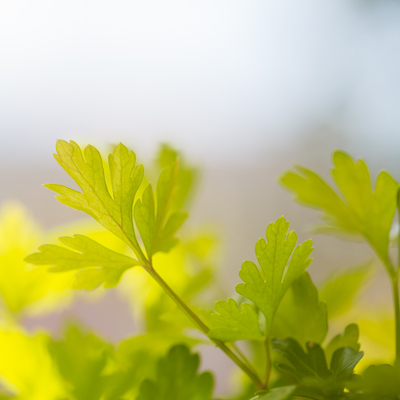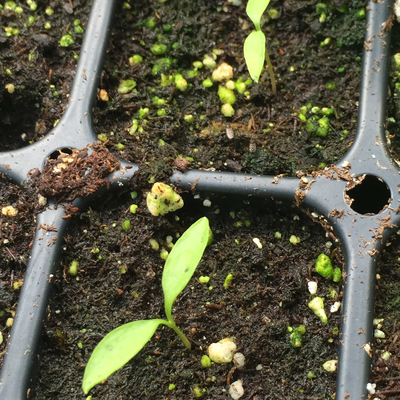Quick facts
- Parsley grows best in well-drained soil that is rich in organic matter.
- Direct seeding is the easiest way to start parsley.
- Parsley is an easy herb to grow indoors.
- Water deeply at least once a week.
- Harvest parsley by snipping off the stalks close to the ground, beginning with the outside stalks.
- Fresh parsley has the best quality.
Common parsley, Petroselinum crispum, is a member of the carrot family (Apiaceae). It is common as a garnish or as a flavoring in many dishes and salads. The curly varieties also make a nice addition to most gardens, planted with other herbaceous plants or used in a border. Native to the Mediterranean area, parsley has a biennial life cycle. Gardeners usually grow it as an annual in our region, because the plants often die during cold winters.
Soil pH and fertility
Soil testing and fertilizer
- Have your soil tested.
- A pH range of 6.0 to 7.0 is best.
- Parsley grows best in well-drained soil that is rich in organic matter.
- Fertilize plants in garden beds once or twice during the growing season, using a 5-10-5 commercial fertilizer at a rate of three ounces per 10 feet of row.
- Use a liquid fertilizer at one-half the label recommended strength every three to four weeks for container-grown plants outside and every four to six weeks for parsley grown indoors.
Selecting plants
Choosing parsley varieties
The most common variety is common or curly parsley, Petroselinum crispum. Curly parsley typically grows 8-14 inches tall. They form dense clumps that are great for borders, interplanting in garden beds, and indoor or outdoor containers.
Italian flat-leaf parsley, P. neapolitanum, is another popular variety. This plant can grow two to three feet tall and is gangly in habit. The flat serrated leaves have a much stronger and sweeter flavor than the other varieties, making it more desirable for cooking.
Hamburg parsley, P. tuberosum, has white, fleshy, parsnip-like roots, used in flavoring soups. It has tall, fern-like leaves.
Japanese parsley, Cryptotaenia japonica, resembles Italian parsley but is not as common. It has a more bitter taste and is present in Asian cuisine.
Planting
Direct seeding
- Direct seeding is the easiest way to start parsley.
- The rate of germination is dependent upon seed freshness, ranging from two to five weeks. To speed up the process, soak the seeds in warm water for up to 24 hours prior to planting.
- As with most herbs, parsley does best in a sunny area that receives direct light for six to eight hours a day. It can tolerate some light shade.
- Sow seeds directly in the ground where you will grow the plants, after danger of spring frosts has passed. Cover seeds with one-eighth inch of soil. Keep them moist.
- Since germination is so slow, it is a good idea to mark the rows.
- Emerging seedlings will appear almost grass-like, with two narrow seed leaves opposite each other. Thin or transplant seedlings when they are two to three inches high.
- Final spacing should be 10-12 inches apart.
Growing indoors
Parsley is an easy herb to grow indoors as long as it has a bright location and holes in the bottom of the pot to ensure good drainage. The plants may be a bit spindly when grown indoors because of lower light levels.
Start seeds indoors in the late winter six to eight weeks before the last frost date.
How to keep your parsley healthy and productive
Watering
- Do not allow the plants to dry out completely between watering in the garden.
- Water deeply at least once a week to ensure the roots are receiving enough moisture during the growing season.
- A light mulch of ground up leaves or grass clippings will help retain moisture and keep weeds to a minimum.
Harvesting
- Harvest parsley by snipping off the stalks close to the ground, beginning with the outside stalks. There will be new growth throughout the growing season if you prune it like this.
- If you just cut the tops off and the leaf stalks remain, the plant will be less productive.
- The plants remain green and productive into fall and can handle light frosts.
- Leave the plants in place after frost kills the foliage. They may resprout in spring, depending on winter conditions.
- Harvest fresh parsley until the plant sends up a seed stalk and dies, completing its biennial life cycle.
- Second year parsley will be more bitter than the previous season’s harvest.
Preservation
- Fresh parsley has the best quality. Although you can dry or freeze it, much flavor is lost.
- Dry the leaves by spreading them on a screen or hanging them upside down in bunches in a warm, well-ventilated room out of direct light.
- For quick drying, dry the leaves in a slow oven at 100-110°F for just a few minutes.
- Store the dried leaves ground or whole in an airtight container away from heat sources or bright light.
- You can also freeze fresh parsley in small bags in the freezer.
- Use parsley preserved by either method within a year's time.
Reviewed in 2024



